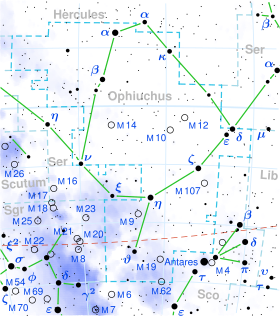| Observation data Epoch J2000 Equinox J2000 | |
|---|---|
| Constellation | Ophiuchus |
| Right ascension | 16h 49m 50.01604s [1] |
| Declination | −10° 46′ 58.7775″ [1] |
| Apparent magnitude (V) | 4.64 [2] |
| Characteristics | |
| Spectral type | F6IV [3] |
| U−B color index | +0.07 [4] |
| B−V color index | +0.47 [4] |
| Astrometry | |
| Radial velocity (Rv) | −1.60 [5] km/s |
| Proper motion (μ) | RA: +72.33 [1] mas/yr Dec.: −78.80 [1] mas/yr |
| Parallax (π) | 31.27±2.16 mas [1] |
| Distance | 104 ± 7 ly (32 ± 2 pc) |
| Absolute magnitude (MV) | 2.13 [2] |
| Orbit [6] | |
| Period (P) | 35.5 ± 1.5 yr |
| Semi-major axis (a) | 0.460 ± 0.030″ |
| Eccentricity (e) | 0.8 ± 0.2 |
| Inclination (i) | 74 ± 11° |
| Longitude of the node (Ω) | 118 ± 9° |
| Periastron epoch (T) | 1981.2 ± 1.7 |
| Argument of periastron (ω) (secondary) | 34 ± 26° |
| Details | |
| 20 Oph A | |
| Mass | 1.70 [7] M☉ |
| Radius | 3.0 [7] R☉ |
| Luminosity | 12.06 [2] L☉ |
| Surface gravity (log g) | 3.89 [8] cgs |
| Temperature | 6,417 [8] K |
| Metallicity [Fe/H] | +0.13 [8] dex |
| Rotational velocity (v sin i) | 11.3 [9] km/s |
| 20 Oph B | |
| Mass | 0.8 ± 0.2 [6] M☉ |
| Other designations | |
| BD−10°4394, FK5 1438, GC 22643, HIP 82369, HR 6243, HD 151769, SAO 160118 | |
| Database references | |
| SIMBAD | data |
20 Ophiuchi is a class F6IV [3] (yellow-white subgiant) star in the constellation Ophiuchus. Its apparent magnitude is 4.64 [2] and it is approximately 104 light years away based on parallax. [1] It lies near the star Zeta Ophiuchi.
20 Ophiuchi is an astrometric binary. The primary star is a late F-type subgiant star. It has a mass 1.72 times that of the Sun. [6] The companion star regularly perturbs the primary star, causing it to wobble around the barycenter. From this, an orbital period of 35.5 years has been calculated. The secondary star is 0.8 times the mass of the Sun, and it may be a white dwarf or red dwarf. [6]
